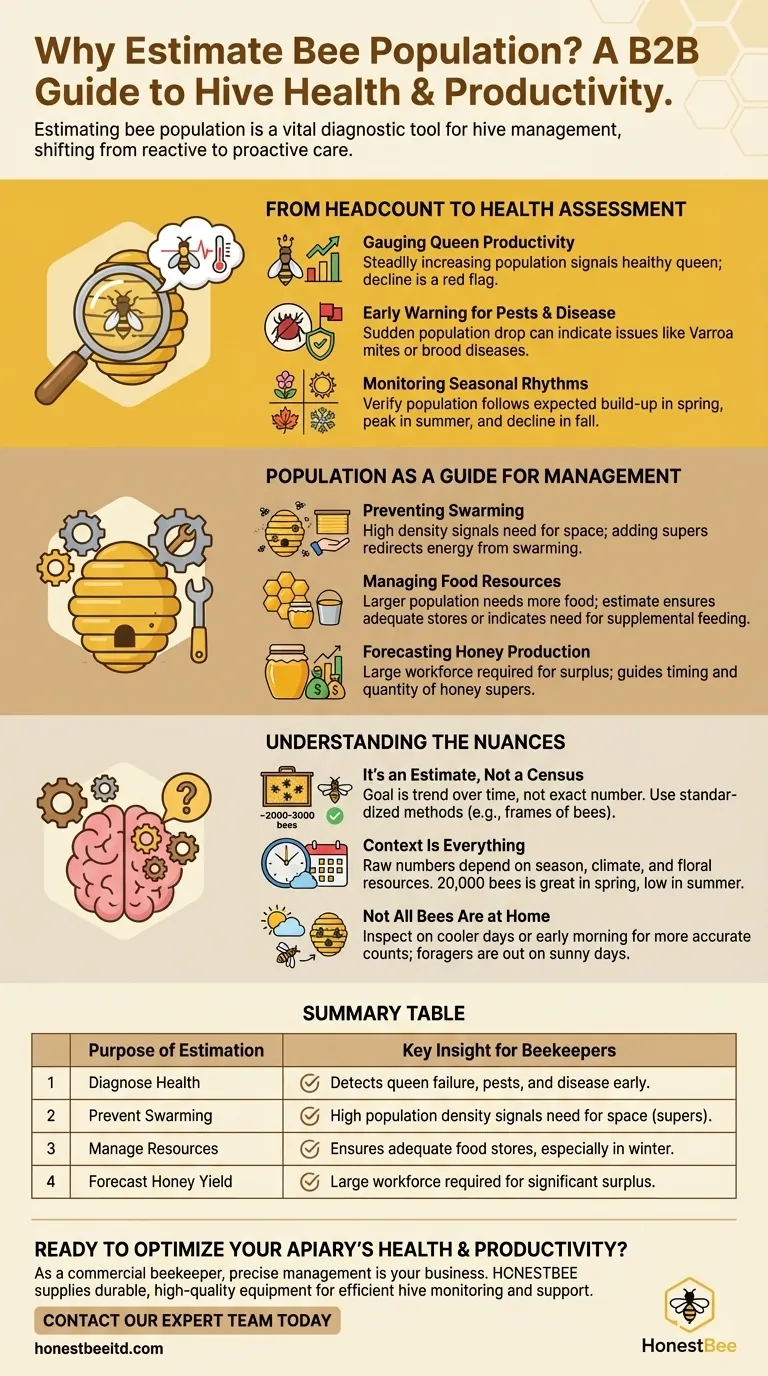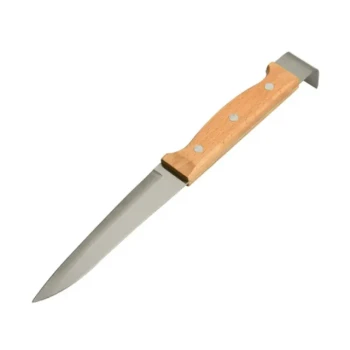At its core, estimating the number of bees in a hive is the primary method a beekeeper uses to diagnose a colony's health and anticipate its future needs. This simple observation allows you to monitor population trends, identify queen productivity, and detect the early signs of stress from pests or disease, informing crucial management decisions like swarm prevention and resource allocation.
Estimating bee population is not about getting a precise headcount. It's about translating a visual assessment into a vital sign for the entire colony, allowing a beekeeper to shift from reacting to crises to proactively managing hive health.

From Headcount to Health Assessment
Think of a bee colony as a single superorganism. Just as a doctor checks your pulse and temperature, a beekeeper assesses population size and density to understand the colony's overall well-being.
Gauging Queen Productivity
A strong, consistently laying queen is the engine of a healthy hive. A steadily increasing bee population, especially in spring, is the most reliable sign that your queen is healthy and productive.
Conversely, a stagnant or shrinking population is a major red flag. It may indicate the queen is failing, is poorly mated, or has been lost, requiring immediate intervention.
Early Warning for Pests and Disease
A sudden, unexplained drop in population is often the first visible symptom of a serious underlying issue. Problems like a severe Varroa mite infestation or brood diseases can decimate a hive's workforce before other signs become obvious.
By tracking population trends, you can spot a decline early and take corrective action before the colony is too weak to recover.
Monitoring Seasonal Rhythms
A colony's population naturally ebbs and flows with the seasons. It builds rapidly in the spring, peaks in the summer, and declines in the fall to a smaller winter cluster.
Estimating the population allows you to verify that your hive is following this expected pattern. A colony that isn't building up in spring, for example, is a clear signal that it needs help.
Population as a Guide for Management
A population estimate is more than just a diagnostic tool; it is a critical piece of data that drives nearly all major beekeeping tasks. It tells you what the colony needs next.
Preventing Swarming
Swarming—the colony's natural method of reproduction—is typically triggered by two things: a strong population and a lack of space.
By observing the density of bees on the frames, a beekeeper can anticipate this impulse. A high population in a crowded hive is a direct signal to add more boxes (supers) to provide space and redirect the bees' energy toward honey storage instead of swarming.
Managing Food Resources
A larger population requires more food. Your estimate helps you determine if the colony has enough honey stores to sustain itself, especially leading into winter or during a nectar dearth.
If a large population faces a period of low nectar flow, you know it may be necessary to provide supplemental feeding to prevent starvation.
Forecasting Honey Production
A large workforce is a prerequisite for a significant honey harvest. Only strong, populous colonies have enough foragers to collect nectar far in excess of their own needs.
Estimating your bee numbers helps you forecast the potential for a honey surplus and decide when and how many honey supers to add.
Understanding the Nuances
While powerful, population estimation is not an exact science. It is a skill that requires context and an understanding of its limitations.
It's an Estimate, Not a Census
The goal is never to count every single bee. Beekeepers use standardized methods, like counting the number of frames fully covered with bees, to get a consistent, repeatable estimate.
One "frame of bees" is often estimated to be around 2,000-3,000 bees. What matters most is not the exact number but the trend over time—is the population growing, stable, or declining?
Context Is Everything
A population of 20,000 bees might be excellent for a colony in early spring but dangerously low for that same colony in mid-summer.
The raw number is meaningless without the context of the time of year, your local climate, and the availability of floral resources.
Not All Bees Are at Home
During a warm, sunny day, a significant portion of the colony's workforce—the foragers—will be out of the hive. An inspection at this time will underestimate the colony's true strength.
For a more accurate assessment of the total population, it is often better to inspect on a cooler, overcast day or earlier in the morning when more bees are inside the hive.
Applying Population Estimates to Your Goals
Your reason for estimating the bee population will depend on your specific objective as a beekeeper.
- If your primary focus is colony survival: Use population trends to detect health declines early and to ensure the hive has adequate food stores for winter.
- If your primary focus is honey production: Use population estimates to ensure your colony reaches maximum strength just before the main nectar flow begins.
- If your primary focus is preventing swarms: Use population density as your key indicator for when to add more space to the hive.
Learning to read the population of your hive is what transforms you from a simple bee-haver into a true beekeeper.
Summary Table:
| Purpose of Estimation | Key Insight for Beekeepers |
|---|---|
| Diagnose Health | Detects queen failure, pests (e.g., Varroa mites), and disease early. |
| Prevent Swarming | High population density signals the need to add space (supers). |
| Manage Resources | Ensures adequate food stores for large populations, especially in winter. |
| Forecast Honey Yield | A large, strong workforce is required for a significant honey surplus. |
Ready to optimize your apiary's health and productivity?
As a commercial beekeeper or distributor, precise hive management is your business. HONESTBEE supplies the durable, high-quality beekeeping supplies and equipment you need to efficiently monitor and support strong colonies. From hive tools to full-scale harvesting systems, our wholesale-focused operations are designed to support your success.
Let's discuss your specific needs. Contact our expert team today to get the right equipment for your operation.
Visual Guide

Related Products
- HONESTBEE Professional Long Handled Hive Tool with Precision Cutting Blade
- Professional Dual-End Stainless Steel Hive Tool for Beekeeping
- HONESTBEE Advanced Ergonomic Stainless Steel Hive Tool for Beekeeping
- HONESTBEE Professional Multi-Functional Hive Tool with Ergonomic Wood Handle
- Multi-Function Plier-Style Frame Grip Hive Tool
People Also Ask
- What is the hive tool used for? The Essential Multi-Tool for Every Beekeeper
- What are the basic tools for beekeeping? Essential Starter Kit for Safe & Successful Hive Management
- Why do hive tools have a hole? Unlock the Secret to Efficient Beekeeping
- How should beekeepers handle bees when using a hive tool? Master Calm, Deliberate Techniques
- How can a hive tool be used to remove propolis and burr comb? Master Hive Maintenance for a Healthy Colony



















